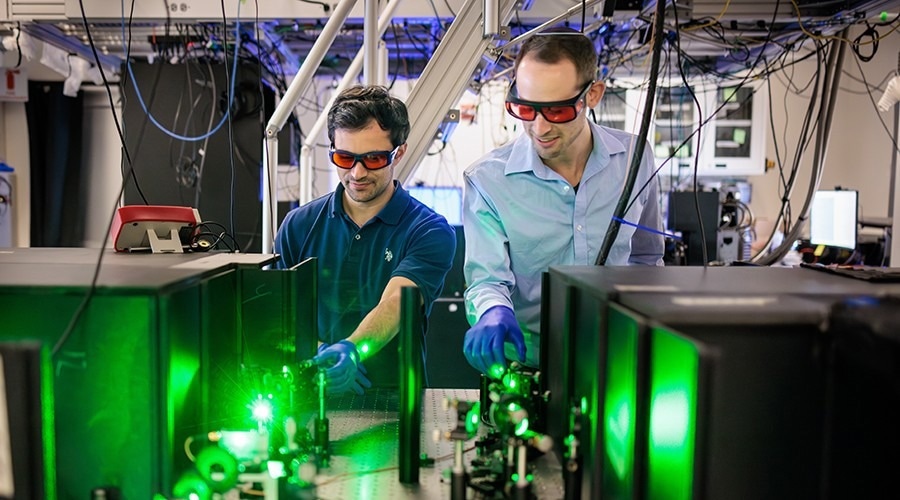Researchers from the University of Chicago Pritzker School of Molecular Engineering (PME) lab of Prof. David Awschalom have developed a novel method to use the defect spin to gauge the behavior of additional single electron defects in the diamond, which was published in Physical Review Letters.
 Researchers in the lab of UChicago Pritzker School of Molecular Engineering Prof. David Awschalom, including Argonne postdoctoral scholar Jonathan Marcks (right) and graduate student Benjamin S. Soloway, have devised a new way to harness the defect spin to measure the behavior of other single electron defects in diamonds. Image Credit: John Zich
Researchers in the lab of UChicago Pritzker School of Molecular Engineering Prof. David Awschalom, including Argonne postdoctoral scholar Jonathan Marcks (right) and graduate student Benjamin S. Soloway, have devised a new way to harness the defect spin to measure the behavior of other single electron defects in diamonds. Image Credit: John Zich
Biological sensor technology or new types of navigation could be made possible by quantum defects acting as ultra-sensitive sensors.
Diamonds' nitrogen vacancy (NV) centers are a specific type of defect system that can measure magnetic fields at the nanoscale. Although scientists are able to manipulate the quantum spin of these centers—single diamond defects where nitrogen has taken the place of carbon—they are still unsure of the best way to separate that spin from the spins of other defects in the material, which could destroy the coherence, or quantum state memory, of the material.
Scientists and engineers can realize the potential of these sensors only by thoroughly examining the atomic-level functioning of this material.
This new knowledge will help develop even more advanced quantum sensors with extended coherence times.
We have devised a way to see certain behavior of single quantum spin states that have otherwise proven elusive to standard measurements. This will impact both how we engineer quantum systems and how we think about charge in many materials.
David Awschalom, Liew Family Professor of Molecular Engineering, Pritzker School of Molecular Engineering, University of Chicago
Finding a Way to Measure Background Noise
The research team synthesizes these NV centers in facilities at Argonne National Laboratory under the direction of Jonathan Marcks, a current Argonne postdoctoral researcher and PME PhD graduate. They can only add a few nanometers of nitrogen dopants to create single NV centers, and they use chemical vapor deposition to grow diamonds layer by layer.
These single-spin defects are highly coherent, but their spin remains sensitive to the behavior of other defect spins in the material. That's because no matter how carefully a diamond is grown, it always contains unintended nitrogen defects with its own spin. This causes decoherence in the system, limiting its usefulness as a sensor.
Even if we have good control over where we put nitrogen, we always end up with this background noise. Because we want to grow highly coherent nitrogen vacancy centers, we wanted to better understand how these surrounding defects behave and couple with each other.
Jonathan Marcks, Postdoctoral Researcher, University of Chicago
Measuring a Nearby Electron Charge
To gain a better understanding of these single nitrogen electronic defects, the team measured the NV center using a laser and a homemade microscope. The number of photons that the NV center emits is determined by its spin state. Since these centers interact with other spins, the researchers discovered that they could use the NV center as a nanoscale sensor of the nearby nitrogen electron charge, that is otherwise invisible.
The process resulted in the first observation of coupled spin and charge dynamics within this material, down to single defects.
Marcks added, “We expected the nitrogen defects would all just have a single charge state, but they actually flip back and forth, and they are not always in the same charge state. That is different from what we assumed from solid-state physics.”
The team collaborated with Prof. Aashish Clerk and Prof. Giulia Galli, whose teams provided theoretical and computational tools to help the researchers better understand their findings.
Finally, the team will apply this knowledge to not only better understand how these material systems behave but also to develop better quantum sensors.
By combining experiment, theory, and computation, we have ideas on how to create extremely clean materials for emerging quantum technologies and control some of these internal noise sources.
Giulia Galli, Liew Family Professor of Molecular Engineering, Pritzker School of Molecular Engineering, University of Chicago
Mykyta Onizhuk, Yu-Xin Wang, Yizhi Zhu, Yu Jin, Benjamin S. Soloway, Masaya Fukami, Nazar Delegan, and F. Joseph Heremans are the other study authors.
The US Department of Energy Office of Science National Quantum Information Science Research Centers funded this study as part of the Q-NEXT center.
Journal Reference:
Marcks, J. C. et. al. (2024) Quantum Spin Probe of Single Charge Dynamics. Physical Review Letters. doi.org/10.1103/PhysRevLett.133.130802